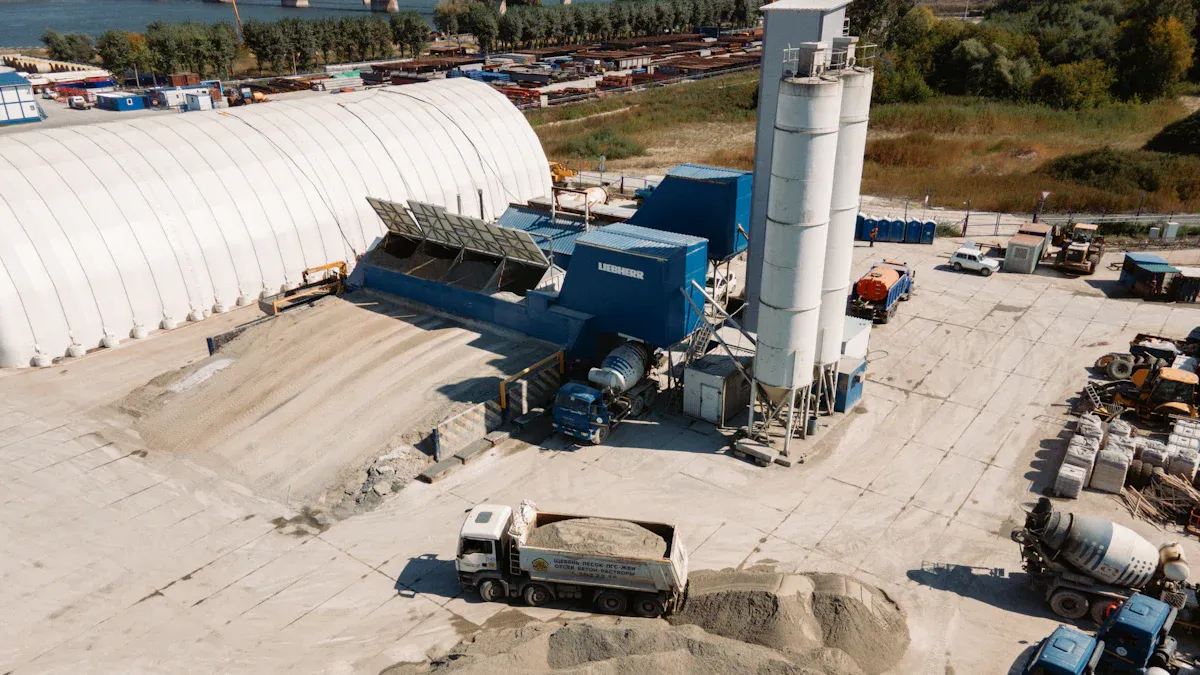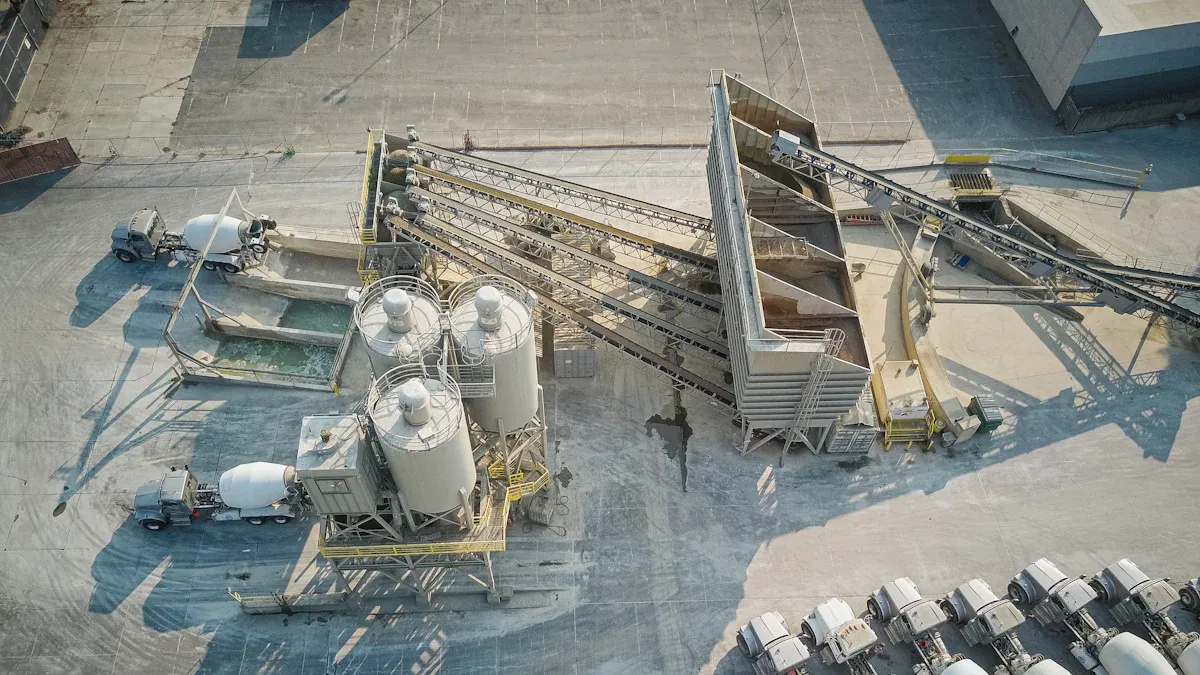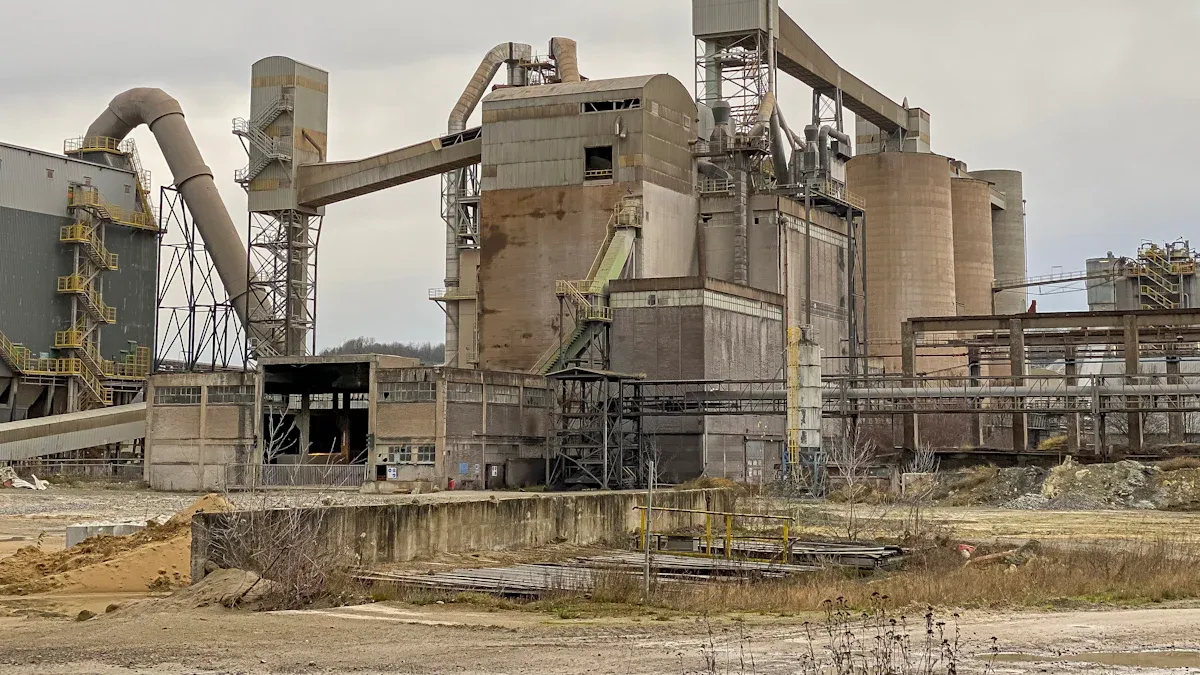
A concrete mixing plant depends on its scraper to function efficiently. You cannot afford to overlook this critical component. Neglecting it leads to reduced performance, expensive downtime, and potential safety hazards. Regular care keeps operations smooth and saves money. By maintaining the scraper, you ensure the plant’s durability and consistent output.

A concrete mixing plant scraper is a mechanical component designed to move and mix materials within the mixer. It ensures that aggregates, cement, and water combine evenly to create high-quality concrete. The scraper typically consists of a blade or paddle that rotates or moves along the mixer’s surface. Its primary function is to prevent material from sticking to the walls and to keep the mixture uniform throughout the process.
The scraper plays a vital role in the mixing process by maintaining consistency and efficiency. It continuously scrapes the inner surface of the mixer, ensuring that all materials are thoroughly blended. Engineering studies reveal that the scraper’s structural design, especially its inclination angle, directly impacts mixing performance. For example, an optimal angle of 45° enhances particle collisions and improves mixing efficiency. This design ensures that the concrete mixing plant operates at its best, producing a homogeneous mixture every time.
You cannot overlook the importance of the scraper in ensuring efficient operations. Without it, materials may stick to the mixer walls, leading to uneven mixing and wasted resources. A well-maintained scraper reduces the risk of downtime caused by clogs or mechanical failures. It also minimizes energy consumption by allowing the mixer to work more effectively. By prioritizing the care of this component, you can maximize the productivity of your concrete mixing plant while reducing operational costs.
Ignoring the scraper in your concrete mixing plant can lead to serious problems. Over time, the scraper blade wears down due to constant friction with materials. This wear reduces its ability to mix effectively, leaving you with uneven concrete. Materials may stick to the mixer walls, creating clogs that disrupt operations. These clogs often require time-consuming manual cleaning, which delays production.
Neglect also increases maintenance costs. A worn scraper puts extra strain on the mixer, causing other components to fail prematurely. For example:
- Concrete mixers are energy-intensive, leading to significant wear on mixing blades.
- Increased wear results in higher maintenance costs.
- Innovations aim to reduce power consumption and minimize wear, but proper care of the scraper remains essential.
By addressing scraper issues early, you avoid these costly consequences and keep your plant running smoothly.
A poorly maintained scraper directly affects the efficiency of your concrete mixing plant. When the scraper cannot perform its job, the mixer requires more energy to achieve the same results. This inefficiency increases power consumption, raising operational costs. Additionally, uneven mixing leads to wasted materials, further driving up expenses.
The relationship between scraper wear and maintenance costs can be seen in the following table:
| Blade Angle | Wear Intensity | Maintenance Implications |
|---|---|---|
| 30° | Highest | Increased maintenance |
| 60° | Lowest | Reduced maintenance |
As the table shows, the blade angle and wear intensity significantly impact maintenance needs. Keeping the scraper in good condition reduces wear and helps you save money in the long run.
Neglecting the scraper also creates safety hazards. Material build-up inside the mixer can cause sudden blockages, leading to equipment malfunctions. These malfunctions put workers at risk of injury. For example, a clogged mixer may overheat or release trapped materials unexpectedly, endangering anyone nearby.
Regular maintenance of the scraper minimizes these risks. By ensuring the scraper operates correctly, you create a safer work environment for your team. Prioritizing safety not only protects your workers but also prevents costly accidents and legal liabilities.
Scrapers in your concrete mixing plant endure constant friction and impact, making wear and tear inevitable. Over time, the scraper blade may lose its sharpness or develop cracks, reducing its ability to mix materials effectively. You can identify these issues by inspecting the blade for visible damage, such as uneven edges or thinning. Pay close attention to the middle trough of scraper conveyors, as research shows this area is highly prone to damage from impact loads. Regular checks help you catch these problems early, preventing operational faults and costly repairs.
Misalignment or improper installation of the scraper can disrupt the mixing process. A misaligned scraper may fail to scrape materials evenly, leading to inconsistent concrete quality. To fix this, ensure the scraper is correctly positioned and securely fastened. Use historical operation data to identify patterns that may indicate alignment issues. Studies suggest that sudden changes in working conditions can affect scraper performance, so adjusting the installation to match production demands is crucial. Proper alignment not only improves efficiency but also extends the scraper's lifespan.
Clogging and material build-up are common issues that can halt operations in your concrete mixing plant. These problems occur when materials stick to the scraper or mixer walls, creating blockages. To prevent this, clean the scraper regularly and remove any residue. Industry guidelines recommend using advanced technologies and best practices to minimize material build-up. For example, maintaining optimal moisture levels in the mix can reduce sticking. By addressing clogging proactively, you ensure smooth operations and consistent output.

Regular inspection and cleaning are essential to keep your scraper in top condition. Neglecting these tasks can lead to material buildup, which damages the mixer and reduces its efficiency. To avoid this, you should clean the scraper and mixer after every use. This practice is especially important for different types of mixers, such as mobile, hydraulic, and portable concrete mixers.
Here are some key steps to follow:
- Inspect the scraper blade for wear, cracks, or thinning edges.
- Check for loose bolts, leaks, or unusual noises during operation.
- Examine electrical and hydraulic components for signs of malfunction.
- Schedule regular cleanings for mobile batching plants to maintain optimal performance.
By following these steps, you can detect issues early and prevent costly repairs. A clean and well-maintained scraper ensures your concrete mixing plant operates smoothly and efficiently.
Lubrication plays a critical role in maintaining the scraper's performance. Without proper lubrication, the scraper's moving parts can wear out quickly, leading to inefficiency and potential breakdowns. You should apply the recommended lubricant to all moving components regularly. This reduces friction and extends the lifespan of the scraper.
Adjustment is equally important. Over time, the scraper may shift out of alignment due to constant use. Misalignment can cause uneven mixing and increase wear on the blade. To fix this, adjust the scraper to its correct position and ensure it is securely fastened. Regularly checking and fine-tuning the scraper's alignment will help maintain consistent mixing quality.
While regular inspections and adjustments are tasks you can handle, scheduling professional servicing is equally important. Professionals have the expertise to identify hidden issues that may not be visible during routine checks. They can also perform advanced maintenance tasks, such as recalibrating the scraper or replacing worn-out parts.
Routine servicing should be scheduled based on the manufacturer's recommendations or the frequency of your plant's operations. For example, a high-capacity concrete mixing plant may require more frequent servicing than a smaller setup. By investing in professional maintenance, you can prevent unexpected breakdowns and ensure the long-term durability of your equipment.
The concrete mixing plant scraper plays a key role in maintaining efficiency and safety. Regular maintenance reduces downtime, improves performance, and extends equipment life. Proactive care also lowers costs, as shown below:
| Benefit | Description |
|---|---|
| Improved Efficiency | Preventive maintenance reduces energy use and operational expenses. |
| Reduced Downtime Costs | Avoiding emergencies saves money by preventing unplanned stoppages. |
| Preventable Failures | Proper care prevents 90% of engine failures. |
| Lower Repair Costs | Early issue detection avoids costly major repairs. |
Prioritizing scraper care ensures smooth operations and long-term productivity.
Inspect the scraper weekly to catch wear and tear early. Regular checks prevent costly repairs and ensure consistent mixing performance. 🛠️
Use a scraper blade gauge to measure wear. A torque wrench ensures proper alignment. These tools simplify maintenance and improve efficiency. 🔧
Yes, improper lubrication increases friction and wear. Apply the recommended lubricant regularly to extend the scraper’s lifespan and maintain smooth operations. 💡